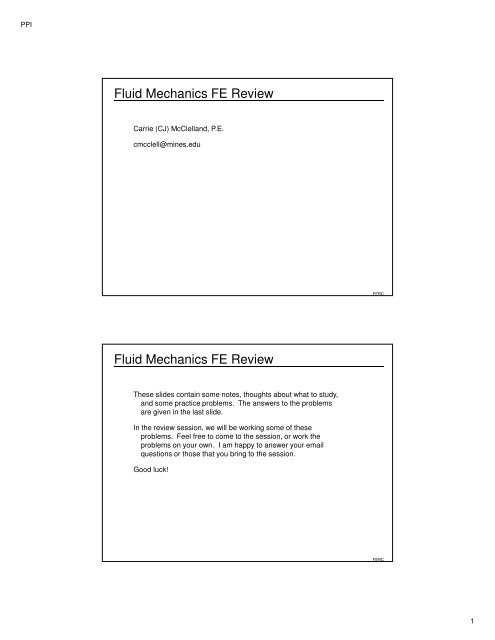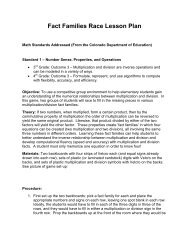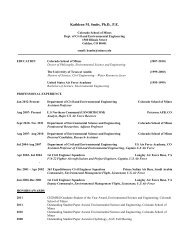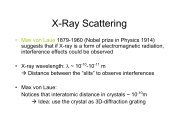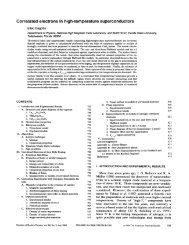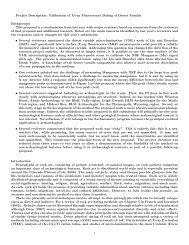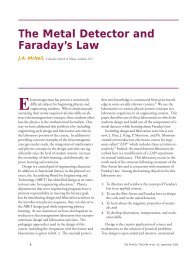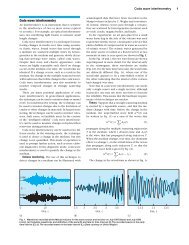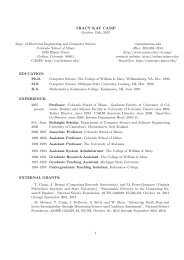Fluid Mechanics FE Review Fluid Mechanics FE ... - Inside Mines
Fluid Mechanics FE Review Fluid Mechanics FE ... - Inside Mines
Fluid Mechanics FE Review Fluid Mechanics FE ... - Inside Mines
You also want an ePaper? Increase the reach of your titles
YUMPU automatically turns print PDFs into web optimized ePapers that Google loves.
PPI<br />
<strong>Fluid</strong> <strong>Mechanics</strong> <strong>FE</strong> <strong>Review</strong><br />
Carrie (CJ) McClelland, P.E.<br />
cmcclell@mines.edu<br />
<strong>Fluid</strong> <strong>Mechanics</strong> <strong>FE</strong> <strong>Review</strong><br />
These slides contain some notes, thoughts about what to study,<br />
and some practice problems. The answers to the problems<br />
are given in the last slide.<br />
In the review session, we will be working some of these<br />
problems. Feel free to come to the session, or work the<br />
problems on your own. I am happy to answer your email<br />
questions or those that you bring to the session.<br />
Good luck!<br />
<strong>FE</strong>RC<br />
<strong>FE</strong>RC<br />
1
PPI<br />
<strong>Fluid</strong> <strong>Mechanics</strong> <strong>FE</strong> <strong>Review</strong><br />
MAJOR TOPICS<br />
<strong>Fluid</strong> Properties<br />
<strong>Fluid</strong> Statics<br />
<strong>Fluid</strong> Dynamics<br />
<strong>Fluid</strong> Measurements<br />
Dimensional Anaysis<br />
<strong>Fluid</strong> <strong>Mechanics</strong> <strong>FE</strong> <strong>Review</strong><br />
It will be very helpful to memorize the following concepts and equations:<br />
• Specific weight, density, and specific gravity<br />
• Hydrostatics pressure equation / manometry<br />
• Force magnitude and location due to hydrostatic pressure for horizontal and<br />
vertical plane walls<br />
• Conservation of mass / continuity<br />
• Conservation of energy / Bernoulli and Energy Eqn<br />
• Darcy Eqn<br />
• Relative roughness equation<br />
• Drag equation<br />
• How to use the Moody Diagram<br />
• Most equations and problems taken from Professional Publications, Inc.<br />
<strong>FE</strong>RC <strong>Review</strong> Course Book<br />
<strong>FE</strong>RC<br />
<strong>FE</strong>RC<br />
2
PPI<br />
<strong>Fluid</strong> <strong>Mechanics</strong><br />
Properties<br />
<strong>Fluid</strong>s<br />
• Substances in either the liquid or gas phase<br />
• Cannot support shear<br />
Make sure you use the ideal gas law when calculating properties for gasses!!<br />
<strong>Fluid</strong> <strong>Mechanics</strong><br />
Properties<br />
Property Symbol &<br />
Equation<br />
Density = <br />
∀<br />
Definition Etc.<br />
<br />
<br />
Specific Weight = density x gravity<br />
Specific Gravity = <br />
<br />
<br />
Viscosity = <br />
<br />
<br />
Kinematic<br />
viscosity<br />
= <br />
<br />
<br />
<br />
<br />
<br />
Make sure you know the relationship between density,<br />
specific weight, and specific gravity!<br />
<strong>FE</strong>RC<br />
<strong>FE</strong>RC<br />
3
PPI<br />
Mass & Weight<br />
1. 10.0 L of an incompressible liquid exert a force of<br />
20 N at the earth’s surface. What force would 2.3 L<br />
of this liquid exert on the surface of the moon? The<br />
gravitational acceleration on the surface of the<br />
moon is 1.67 m/s 2<br />
(A) 0.39 N<br />
(B) 0.78 N<br />
(C) 3.4 N<br />
(D) 4.6 N<br />
Professional Publications, Inc.<br />
<strong>Fluid</strong> <strong>Mechanics</strong> – <strong>Fluid</strong> Properties<br />
Definitions<br />
Property Symbol &<br />
Equation<br />
Vapor Pressure <br />
Bulk Modulus = <br />
∀<br />
Speed of Sound , = ⁄ <br />
, = <br />
Definition Etc.<br />
Pressure at which<br />
liquid and vapor are in<br />
equilibrium<br />
<br />
<br />
Velocity of propegation<br />
of a small wave<br />
Used to predict<br />
cavitation (local<br />
pressure < vapor<br />
pressure<br />
k = Bulk modulus<br />
= 1.4<br />
<strong>FE</strong>RC<br />
<strong>FE</strong>RC<br />
4
PPI<br />
Mach Number<br />
2. A jet aircraft is flying at a speed o f 1700 km/h.<br />
The air temperature is 20°C. The molecular<br />
weight of air is 29 g/mol. What is the Mach<br />
number of the aircraft?<br />
(A) 0.979<br />
(B) 1.38<br />
(C) 1.92<br />
(D) 5.28<br />
Professional Publications, Inc.<br />
<strong>Fluid</strong> <strong>Mechanics</strong> – <strong>Fluid</strong> Properties<br />
Definitions<br />
Property Symbol &<br />
Equation<br />
Surface Tension = <br />
<br />
Capillary Rise 4 <br />
ℎ =<br />
Definition Etc.<br />
<br />
<br />
Distance a liquid will<br />
rise (or fall) in a “tube”<br />
d<br />
Professional Publications, Inc.<br />
<strong>FE</strong>RC<br />
<strong>FE</strong>RC<br />
5
PPI<br />
Surface Tension<br />
3. A 2 mm (inside diameter) glass tube is placed in a<br />
container of mercury. An angle of 40°is<br />
measured as illustrated. The density and surface<br />
tension of mercury are 13550 kg/m 3 and 37.5 x<br />
10 -2 N/m, respectively. How high will the mercury<br />
rise or be depressed in the tube as a result of<br />
capillary action?<br />
(A) -4.3 mm (depression)<br />
(B) -1.6 mm (depression)<br />
(C) 4.2 mm (rise)<br />
(D) 6.4 mm (rise)<br />
<strong>Fluid</strong> <strong>Mechanics</strong><br />
Stresses and Viscosity<br />
Shear Stress<br />
• Normal Component:<br />
• Tangential Component<br />
- For a Newtonian fluid:<br />
Professional Publications, Inc.<br />
= <br />
<br />
- For a pseudoplastic or dilatant fluid:<br />
Professional Publications, Inc.<br />
(v = velocity)<br />
<strong>FE</strong>RC<br />
9-1b<br />
Absolute Viscosity = µ = Ratio of shear stress to rate of shear deformation<br />
<strong>FE</strong>RC<br />
6
PPI<br />
Viscosity<br />
4. A sliding-plate viscometer is used to measure the<br />
viscosity of a Newtonian fluid. A force of 25 N is<br />
required to keep the top plate moving at a<br />
constant velocity of 5 m/s. What is the viscosity of<br />
the fluid?<br />
(A) 0.005 N-s/m 2<br />
(B) 0.04 N-s/m 2<br />
(C) 0.2 N-s/m 2<br />
(D) 5.0 N-s/m 2<br />
<strong>Fluid</strong> Statics<br />
Professional Publications, Inc.<br />
Professional Publications, Inc.<br />
<strong>FE</strong>RC<br />
<strong>FE</strong>RC<br />
7
PPI<br />
Manometry<br />
5. An open water manometer is used to<br />
measure the pressure in a tank. The<br />
tank ifs half-filled with 50,000 kg of a<br />
liquid chemical that is not miscible in<br />
water. The manometer tube is filled with<br />
liquid chemical. What is the pressure in<br />
the tank relative to the atmospheric<br />
pressure?<br />
(A) 1.4 kPa<br />
(B) 1.9 kPa<br />
(C) 2.4 kPa<br />
(D) 3.4 kPa<br />
<strong>Fluid</strong> Statics<br />
Barometer<br />
Atmospheric Pressure<br />
Professional Publications, Inc.<br />
Professional Publications, Inc.<br />
<strong>FE</strong>RC<br />
9-2c<br />
<strong>FE</strong>RC<br />
8
PPI<br />
<strong>Fluid</strong> Statics<br />
Hydrostatics<br />
6. A 6m x 6m x 6m vented cubical tank is half-filled<br />
with water; the remaining space is filled with oil<br />
(SG=0.8). What is the total force on one side of<br />
the tank?<br />
(A) 690 kN<br />
(B) 900 kN<br />
(C) 950 kN<br />
(D) 1.0 MN<br />
Professional Publications, Inc.<br />
<strong>FE</strong>RC<br />
<strong>FE</strong>RC<br />
9
PPI<br />
<strong>Fluid</strong> Statics Examples<br />
Example 1 (<strong>FE</strong>IM):<br />
The tank shown is filled with water. At<br />
what depth does the resultant force act?<br />
The surface under pressure is a<br />
rectangle 1 m at the base and<br />
2.31 m tall.<br />
<strong>Fluid</strong> Statics Examples<br />
Professional Publications, Inc.<br />
A = bh<br />
Iy = c b3h 12<br />
Z 4 m<br />
c = = 4.618 m<br />
sin60°<br />
Using the moment of inertia for a rectangle given in the NCEES<br />
Handbook,<br />
z* = I y c<br />
AZ c<br />
=<br />
b<br />
=<br />
3 h<br />
12bhZc = b2<br />
12Z c<br />
(2.31 m) 2<br />
= 0.0963 m<br />
(12)(4.618 m)<br />
R depth = (Z c + z*) sin 60°= (4.618 m + 0.0963 m) sin 60°= 4.08 m<br />
Professional Publications, Inc.<br />
9-2f1<br />
<strong>FE</strong>RC<br />
9-2f2<br />
<strong>FE</strong>RC<br />
10
PPI<br />
<strong>Fluid</strong> Statics Examples<br />
Example 2 (<strong>FE</strong>IM):<br />
The rectangular gate shown is 3 m<br />
high and has a frictionless hinge at<br />
the bottom. The fluid has a density of<br />
1600 kg/m 3 . The magnitude of the<br />
force F per meter of width to keep the<br />
gate closed is most nearly<br />
(A) 0 kN/m<br />
(B) 24 kN/m<br />
(C) 71 kN/m<br />
(D) 370 kN/m<br />
Hydrostatics<br />
Professional Publications, Inc.<br />
pave = ρgzave (1600 kg<br />
m 3)(9.81m<br />
s<br />
= 23544 Pa<br />
9-2g<br />
R is one-third from the bottom (centroid<br />
of a triangle from the NCEES Handbook).<br />
Taking the moments about R,<br />
2F = Fh F ⎛ 1<br />
= ⎜<br />
w ⎝ 3<br />
⎞<br />
⎟<br />
⎠<br />
R ⎛<br />
⎜<br />
⎝ w<br />
⎞<br />
⎟ =<br />
⎠<br />
Therefore, (B) is correct.<br />
1<br />
2)( 2<br />
)(3 m)<br />
R<br />
w = paveh = (23544 Pa)(3 m) = 70662 N/m<br />
F + Fh = R<br />
6. A gravity dam has the cross section shown. What<br />
is the magnitude of the resultant water force (per<br />
meter of width) acting on the face of the dam?<br />
(A) 7.85 MN/m<br />
(B) 12.3 MN/m<br />
(C) 14.6 MN/m<br />
(D) 20.2 MN/m<br />
Professional Publications, Inc.<br />
70,667 N<br />
m = 23.6 kN/m<br />
3<br />
<strong>FE</strong>RC<br />
<strong>FE</strong>RC<br />
11
PPI<br />
Buoyancy<br />
Archimedes’ Principle and Buoyancy<br />
• The buoyant force on a submerged or floating object is equal to the<br />
weight of the displaced fluid.<br />
• A body floating at the interface between two fluids will have buoyant<br />
force equal to the weights of both fluids displaced.<br />
F buoyant = γ water V displaced<br />
Buoyancy<br />
8. A 35 cm diameter solid sphere (ρ =<br />
4500 kg/m 3 ) is suspended by a<br />
cable as shown. Half of the sphere<br />
is in one fluid (ρ = 1200 kg/m 3 ) and<br />
the other half of the sphere is in<br />
another (ρ = 1500 kg/m 3 ). What is<br />
the tension in the cable?<br />
(A) 297 N<br />
(B) 593 N<br />
(C) 694 N<br />
(D) 826 N<br />
Professional Publications, Inc.<br />
ρ=1200 kg/m 3<br />
ρ=1500 kg/m 3<br />
<strong>FE</strong>RC<br />
<strong>FE</strong>RC<br />
12
PPI<br />
<strong>Fluid</strong> Dynamics<br />
(might be called the field eqn.)<br />
Continuity Equation Example<br />
Example (<strong>FE</strong>IM):<br />
The speed of an incompressible fluid is 4 m/s entering the 260 mm pipe.<br />
The speed in the 130 mm pipe is most nearly<br />
(A) 1 m/s<br />
(B) 2 m/s<br />
(C) 4 m/s<br />
(D) 16 m/s<br />
A1v 1 = A2v 2<br />
A1 = 4A2 so v2 = 4v 1 = ( 4)<br />
4<br />
Therefore, (D) is correct.<br />
m ⎛ ⎞<br />
⎜ ⎟ = 16 m/s<br />
⎝ s ⎠<br />
Professional Publications, Inc.<br />
<strong>FE</strong>RC<br />
9-3c<br />
<strong>FE</strong>RC<br />
13
PPI<br />
Bernoulli Equation<br />
9. The diameter of a water pipe gradually changes<br />
from 5 cm at point A to 15 cm at point B. Point A is<br />
5 m lower than point B. The pressure is 700 kPa at<br />
point A and 664 kPa at point B. Friction between<br />
the water and the pipe walls is negligible. What is<br />
the rate of discharge at point B?<br />
(A) 0.0035 m 3 /s<br />
(B) 0.0064 m 3 /s<br />
(C) 0.010 m 3 /s<br />
(D) 0.018 m 3 /s<br />
Professional Publications, Inc.<br />
Bernoulli – Flow from a Jet<br />
10. A liquid with a specific gravity of 0.9 is stored in a<br />
pressurized, closed storage tank. The tank is<br />
cylindrical with a 10 m diameter. The absolute<br />
pressure in the tank above the liquid is 200 kPa.<br />
What is the initial velocity of a fluid jet when a 5 cm<br />
diameter orifice is opened at point A?<br />
(A) 11.3 m/s<br />
(B) 18.0 m/s<br />
(C) 18.6 m/s<br />
(D) 23.9 m/s<br />
Professional Publications, Inc.<br />
15 cm<br />
5m<br />
<strong>FE</strong>RC<br />
<strong>FE</strong>RC<br />
14
PPI<br />
Flow in Pipes – <strong>Fluid</strong> Dynamics and Friction<br />
Steady, Incompressible Flow<br />
Reynolds Number<br />
For a Newtonian fluid:<br />
D = hydraulic diameter = 4R H<br />
ν = kinematic viscosity<br />
µ = dynamic viscosity<br />
For a pseudoplastic or dilatant fluid:<br />
Professional Publications, Inc.<br />
<strong>FE</strong>RC<br />
9-3g<br />
<strong>FE</strong>RC<br />
15
PPI<br />
<strong>Fluid</strong> Dynamics and Friction<br />
11. A steel pipe with an inside diameter of 25 mm is<br />
20 m long and carries water at a rate of 4.5 m 3 /h.<br />
Assuming the specific roughness of the pipe is<br />
0.00005 m, the water has an absolute viscosity of<br />
1.00 x 10 -3 Pa-s and a density of 1000 kg/m 3 ,<br />
what is the friction factor?<br />
(A) 0.023<br />
(B) 0.030<br />
(C) 0.026<br />
(D) 0.028<br />
Professional Publications, Inc.<br />
Non-Circular Conduits, Open Channel Flow,<br />
and Partially Full Pipes<br />
<strong>FE</strong>RC<br />
<strong>FE</strong>RC<br />
16
PPI<br />
Hydraulic Radius<br />
12. What is the hydraulic radius of the trapezoidal<br />
irrigation canal shown?<br />
(A) 1.63 m<br />
(B) 2.00 m<br />
(C) 2.13 m<br />
(D) 4.00 m<br />
Professional Publications, Inc.<br />
Hydraulic Grade Line and Energy Grade Line<br />
Pump Power<br />
Professional Publications, Inc.<br />
<strong>FE</strong>RC<br />
<strong>FE</strong>RC<br />
17
PPI<br />
Multi-path Pipelines<br />
Multi-path pipelines<br />
13. The Darcy friction factor for both of the pipes<br />
shown is 0.024. The total flow rate is 300 m 3 /h.<br />
What is the flow rate through the 250 mm pipe?<br />
(A) 0.04 m 3 /s<br />
(B) 0.05 m 3 /s<br />
(C) 0.06 m 3 /s<br />
(D) 0.07 m 3 /s<br />
Professional Publications, Inc.<br />
<strong>FE</strong>RC<br />
<strong>FE</strong>RC<br />
18
PPI<br />
Implulse-Momentum<br />
Be sure to familiarize yourself with how this equation works for bends,<br />
enlargements, contractions, jet propulsion, fixed blades, moving blades,<br />
and impulse turbines.<br />
Impulse-Momentum<br />
Pipe Bends, Enlargements, and<br />
Contractions<br />
Professional Publications, Inc.<br />
<strong>FE</strong>RC<br />
9-6a<br />
<strong>FE</strong>RC<br />
19
PPI<br />
Impulse-Momentum<br />
14. Water is flowing at 50 m/s through a 15 cm<br />
diameter pipe. The pipe makes a 90 degree<br />
bend, as shown. What is the reaction on the<br />
water in the z-direction at the bend?<br />
(A) -44 kN<br />
(B) -33 kN<br />
(C) 14 kN<br />
(D) 44 kN<br />
Professional Publications, Inc.<br />
Flow and Pressure Measurement<br />
<strong>FE</strong>RC<br />
<strong>FE</strong>RC<br />
20
PPI<br />
<strong>Fluid</strong> <strong>Mechanics</strong><br />
<strong>Fluid</strong> Measurements<br />
Pitot Tube – measures flow velocity<br />
Professional Publications, Inc.<br />
9-10a<br />
• The static pressure of the fluid at the depth of the pitot tube (p 0) must be<br />
known. For incompressible fluids and compressible fluids with M ≤ 0.3,<br />
Flow and Pressure Measurement<br />
15. The density of air flowing in a duct is 1.15 kg/m 3 .<br />
A pitot tube is placed in the duct as shown. The<br />
static pressure in the duct is measured with a wall<br />
tap and pressure gage. Use the gage readings to<br />
determine the velocity of the air.<br />
(A) 42 m/s<br />
(B) 102 m/s<br />
(C) 110 m/s<br />
(D) 150 m/s<br />
Professional Publications, Inc.<br />
<strong>FE</strong>RC<br />
<strong>FE</strong>RC<br />
21
PPI<br />
<strong>Fluid</strong> <strong>Mechanics</strong><br />
<strong>Fluid</strong> Measurements<br />
Venturi Meters – measures the flow rate in a pipe system<br />
• The changes in pressure and elevation determine the flow rate. In<br />
this diagram, z 1 = z 2, so there is no change in height.<br />
<strong>Fluid</strong> <strong>Mechanics</strong><br />
<strong>Fluid</strong> Measurements<br />
Orifices<br />
Professional Publications, Inc.<br />
Professional Publications, Inc.<br />
9-10c<br />
<strong>FE</strong>RC<br />
9-10e<br />
<strong>FE</strong>RC<br />
22
PPI<br />
Orifice Flow<br />
16. Water flows out of a tank at 12.5 m/s from an<br />
orifice located 9m below the surface. The crosssectional<br />
area of the orifice is 0.002 m 2 , and the<br />
coefficient of discharge is 0.85. What is the<br />
diameter D, at the vena contracta?<br />
Similitude<br />
(A) 4.2 cm<br />
(B) 4.5 cm<br />
(C) 4.7 cm<br />
(D) 4.8 cm<br />
Professional Publications, Inc.<br />
In other words… Dimensionless parameters must be equal between the model and prototype<br />
(Each dimensionless parameter is a ratio of different types of forces being exerted on the fluid)<br />
For example:<br />
For completely submerged models/prototypes and pipe flow, the Reynolds numbers must be equal<br />
For Weirs, dams, ships, and open channels, the Froude numbers must be equal<br />
<strong>FE</strong>RC<br />
<strong>FE</strong>RC<br />
23
PPI<br />
Similitude – Dimensionless Parameters<br />
Similitude<br />
Professional Publications, Inc.<br />
17. A nuclear submarine is capable of a top<br />
underwater speed of 65 km/h. How fast would a<br />
1/20 scale model of the submarine have to be<br />
moved through a testing pool filled with seawater<br />
for the forces on the submarine and model to be<br />
dimensionally similar?<br />
(A) 0.90 m/s<br />
(B) 18 m/s<br />
(C) 180 m/s<br />
(D) 360 m/s<br />
Professional Publications, Inc.<br />
<strong>FE</strong>RC<br />
<strong>FE</strong>RC<br />
24
PPI<br />
Drag<br />
Typically these problems will be “plug and chug”<br />
Drag Coefficients for Spheres and Circular Flat Disks<br />
ANSWERS!!<br />
1. B<br />
2. B<br />
3. A<br />
4. B<br />
5. A<br />
6. B<br />
7. C<br />
8. C<br />
9. C<br />
10.C<br />
11.C<br />
12.C<br />
13.C<br />
14.D<br />
15.A<br />
16.D<br />
17.D<br />
Professional Publications, Inc.<br />
Professional Publications, Inc.<br />
<strong>FE</strong>RC<br />
<strong>FE</strong>RC<br />
25


